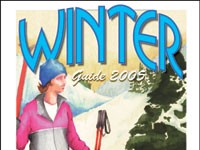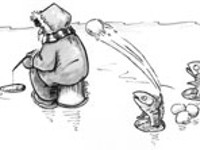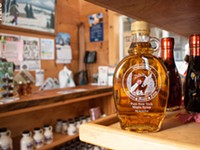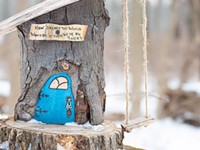[
{
"name": "500x250 Ad",
"insertPoint": "5",
"component": "15667920",
"parentWrapperClass": "",
"requiredCountToDisplay": "1"
}
]
It's become a dull cliché to say that the best cooking is that which cooks least, starting with the finest, freshest produce. It's kind of a French idea ripped into California overdrive by food gurus like Alice Waters of Chez Panisse fame. And well, yeah, great produce handled with a light touch usually results in pretty good eats, but who didn't know that? Also, where besides California do we have access to the freshest of everything all year round? Sure, Wegmans brings us fine produce from all over the world, but it's often worse for travel and prohibitively expensive.
Fortunately for those of us living in wintry climes, people have been eating without fresh produce for millennia. And in many cultures, that very restriction led to the development of amazingly varied cuisine. Curious how many ways dried lentils can be used? Spend a little time in India and find out. Dried beans and rice, together, form the nutritional basis for many diets around the world, and therefore we have countless, spectacular rice and bean dishes from which to choose. Plenty of the world's tastiest food amounts to taking a tiny bit of protein and jazzing it up (think Creole stews or even sushi in Japan).
So, in honor of winter, I asked some cooks to contribute recipes that don't require fresh ingredients. We decided to allow onions, potatoes, garlic, and winter squash, all of which keep very well. But no easily perishable fruits, veggies, or meats. The responses were most intriguing (and everybody wanted to cheat just a little).
Marwan el-Bejjani, manager at Sinbad's, suggested an African peanut butter stew. He says it's easy, but tastes like you slaved over it all day. It starts with a dark roux: melt 1/2 a stick of margarine until it's clear, whisk in 2 tablespoons flour, and cook until it turns dark brown, stirring frequently.
Meanwhile, sauté one large, diced Spanish onion in a cup of vegetable oil (don't brown). Add a couple of cloves finely chopped garlic, 3 tablespoons gumbo file, and 1 tablespoon dried basil, and cook about 5 minutes. Add a can of stewed tomatoes and a small can of tomato sauce, and cook over low heat for 2 minutes. Dump in a package of frozen, chopped spinach and half a package of frozen, chopped okra. Then add two cups of chicken broth, one cup of smooth peanut butter, and salt and pepper to taste. Stir in the dark roux, cook 15 minutes, and serve it with rice made with chicken broth.
Ain't nothing wrong with using frozen or canned goods properly. Sure, you don't want to slice canned tomatoes for insalata Caprese, but for cooking, a good Italian brand of canned tomatoes will be better than fresh at least nine months of the year in our climate.
Paula Wolfert provides a pile of ways to cook beans in her Cooking of the Eastern Mediterranean (and many other recipes that would conform to these rules). I'm crazy about a Georgian red bean dish in which you cook the dried beans slowly in stages, first by themselves, then with lots of onions, then with hard spices like cinnamon and clove. When it cooks down, you add bright flavors right at the end --- lemon juice and pomegranate molasses --- and give it a day in the fridge to develop. It's outstanding with warm pita bread (write me at [email protected] if you want the recipe, but you'll never regret buying the book).
My friends Laurie and John Perry always serve great food, and their caramelized apricot-onion tarts sound outrageous. Get yourself some ready-made phyllo shells to save some effort, or make your own if you're ambitious. Cook half a pound of diced bacon until just crisp, and drain, reserving a couple tablespoons of the fat in the pan (bacon, being a preserved meat, is within my rules).
Add about 2 pounds of Vidalia onions, cut into 1/4 inch slices, and 1 tablespoon sugar, and caramelize over medium heat (about 40 minutes). Add 1/4 cup brandy and stir. Then mix in the bacon, 1/2 cup finely chopped dried apricots, and salt, pepper, and red pepper flakes to taste. Cook until all the liquid evaporates. Add 2 tablespoons fresh Thyme leave --- if you have them... yeah, that breaks the rules --- and remove from the heat. Put one slice of Taleggio cheese and about a tablespoon of the onion mixture in each shell, sprinkle with a bit more fresh thyme, and bake at 350 degrees for 8 to 10 minutes. Can't you just smell them?
Independent radio reporter-producer Isobel don't-call-me-"personality" Neuberger always has tasteful recipes, and though I attempted to avoid the French, she reminded me that potatoes Lyonnaise fits within the rules. What could be better than onions, butter, salt, pepper, and potatoes, cooked gently in a gratin dish? Again, e-mail if you want Isobel's recipe (which comes from Classic Home Cooking by Berry & Spieler).
There is no cooking challenge that grilling champs Dan and Betty Nolan won't meet. Dan sent two soup recipes that he was able to modify to meet the criteria. For tortilla soup a la Dan, start by cutting 4 corn tortillas into strips, and then baking them for 10 minutes at 350 degrees. Set those aside, and soften a chopped onion and a couple of ribs of celery in a tablespoon of olive oil (a red bell pepper would be nice if not for the rules). Add a chopped garlic clove and soften it (about 2 minutes), then add a can of tomato puree, the juice of a lime, a can of green chiles, 4 cups unsalted chicken broth, marjoram, thyme, cumin, and chopped jalapeño (available in cans). Bring it to a boil, reduce the heat, and simmer for 10 minutes.
To serve, spread the tortilla strips in the bottoms of 4 bowls. Then add cubes of Monterrey Jack cheese, and top it all with the soup. A grind of black pepper and some fresh cilantro (which you don't have) go nice on top. Dan also sent a recipe for winter vegetable soup with barley, also available by e-mail.
When I ask my itinerant chef buddy, Greg Duva, for this sort of info, he invariably delivers in spades. In this case, he sent a recipe for a roasted root vegetable stock that can be used in place of traditional, meat-based stocks. Root vegetables like carrot, parsnip, and turnip are great in winter not only because they keep so well, but because they have such deep flavor.
To make his stock, Greg roasts all those veggies, plus onion and garlic, in a roasting pan lightly coated in olive oil. Roast at 425 degrees for about 45 minutes, turning the vegetables once or twice. "This gentle caramelization of the natural vegetable sugars is what you are looking for," Greg says, "the process by which their rich depth of flavor is concentrated and released in place of the meat juices which flavor traditional brown stocks."
When you've got them roasted, put them in a stockpot with tomatoes (canned, if you want to stick to the rules), bay leaf, thyme, and peppercorn, then cover by 2 inches with cold water. Simmer gently for a couple of hours, then strain twice to get all the solids out. Drop me a line if you want a more involved version of the recipe and Greg's instructions for turning the stock into a demiglace.
Pasta, of course, is a dried food. But don't forget about grains. In addition to rice, you can do great things with bulgur, corn, and barley. And nuts are great in winter. Dried and smoked meats and fish are just fine year-round, too. And if you must have fresh vegetables, Brussels sprouts are still growing and better than ever when the weather gets cold. Keep warm, and keep eating well without going broke or subsidizing California farming.
In This Guide...
Latest in Winter Guide
More by Adam Wilcox
-

Miché Fambro and the meaning of success
Feb 1, 2021 -

Ariana Kabob House
Jan 3, 2007 -
"Truly Hairy Fairy Tales"
Dec 27, 2006 - More »











